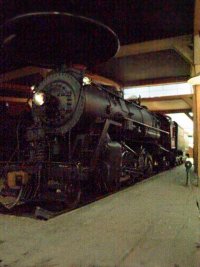| |
|
By the time the NC had modernized and
upgraded its steam fleet, no 0-6-0’s were in
service. All switching was taken care of by 2-8-0’s
and some early Diesel switchers. Yet, I have a model
of an 0-6-0 I can’t part with. To incorporate
it into the scheme of things, it wound up as NC
760.
This engine is a Tyco “Big Six” that
was my very first HO scale steam engine in the fifties.I
have added a few things to it over the years, and
NC-ized it. This engine is so smooth and quiet (having
a Helix Humper motor/flywheel kit in it) that you
can hear the side rods click as she passes. Yes,
it is quite worn out but still serves every day. |
|
To add to the confusion of transition era operations
and replace ageing steamers, the NC ordered five
steam generator equipped GP-7’s. These engines
were used to serve branch line passenger operations,
and a few worked mainline trains such as the remnant
of the City of Memphis. Painted in passenger scheme,
754 is an Athearn model upgraded, re-detailed and
custom painted in that scheme. This shot shows 754
with the “City” and a little extra rare
head-end business this day. The train is VERY late.
By 1955 the City was one bedraggled Geep and two,
maybe three cars. By 1958 the train was gone. |
|
Steam engine 651 and crewman foul the switch
at Kayne west end. It does not matter, for they are
only stopped for a moment to line up another switch.
This is my first scratch-built steamer, built in
1970-71. The chassis is a PennLine Pennsy Decapod
that has been shortened by one driving axle and a
trailing truck added. It still has the original Pittman
motor and runs as if it has a can motor in it. Another
engine with over thirty years of service, it clanks
along almost like the prototype. I like the smoke
and sky effects Maryann added. |
|
The Kayne Ave Turntable was for
turning most anything that was pointed the wrong
way. On dynamometer
cars, the “Business end” of the car was
where the cupola is, and it faced forwards in operation.
Here 90130 gets turned for another trip down to Cowan
and the Cumberland Mountain for more testing. There
is some question if the car was Tuscan red or Pullman
green when originally on the NC. This car is a standard
unmodified (except for inspection lights and full,
lighted interior with crew) custom decorated Walthers
Dyno car. This car now belongs to Terry Coats, NCPS
VP. |
|
Stainless fluted car 100 is two Varney shorty cars
spliced together. A coach and observation car were
used to make this 82’ car and experiment with
stainless steel painting techniques. I painted the
car with gloss black laquer then sprayed two coats
of Rustoleum High Temperature Aluminum over it when
well dried. The result is very convincing, but the
aluminum is easy to scratch. Clear coat sealer does
not work on test samples and dulls the paint. Here,
the windows are yet to be added. There was no prototype
for this car on the NC, it is just for fun. |
 |
Engine 673 is one of two identical class L-3 Mikados
I built as a logical extension of the L-2 class.
These engines both have synchronized sound and double
heading is startling. They are built from almost
exclusively Tyco parts, except for the Buehler can
motors, A-Line flywheels and sparse additions of
Cal Scale details. Big visual change is the addition
of old Rivarossi USRA cabs. They utilize the Mantua “Power
Drive” gear box system and run like a dream.
All drivers are flanged, and they will negotiate
22” radius curves and number 4 turnouts. The
scratch-built roundhouse is over thirty years old
and has complete lights and some interior detail,
but retains the original brass rails! |
|
|























